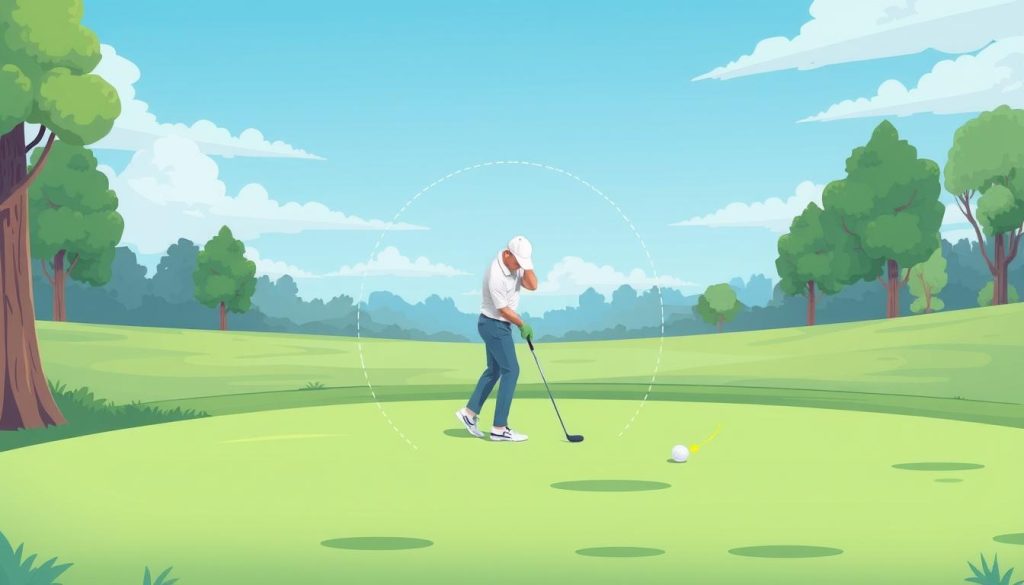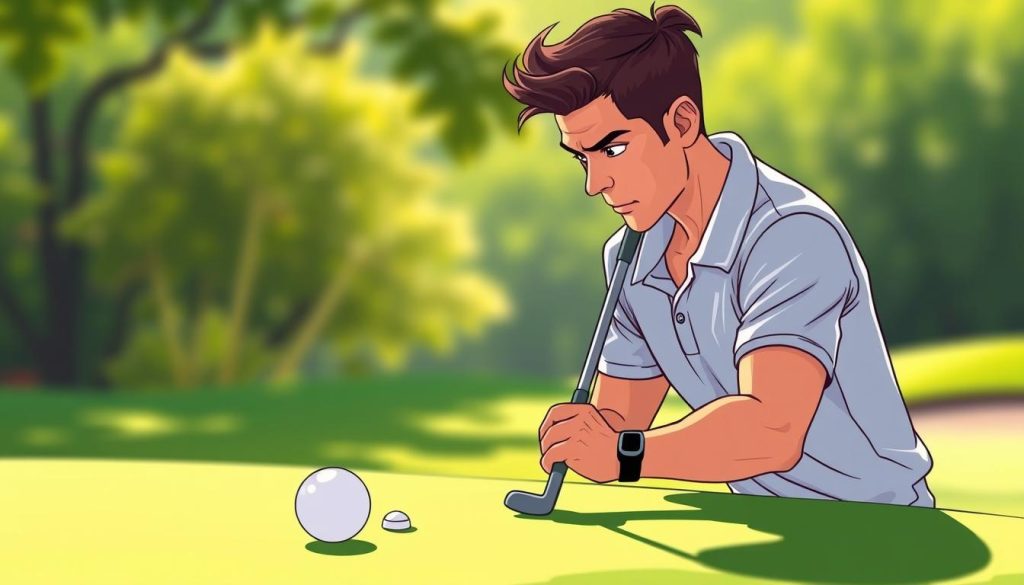Golf putting is a delicate art that needs precision, focus, and mental strength. This guide explores stroke visualization, a powerful mental technique. It can greatly improve your putting accuracy and consistency on the green. By using your mind’s eye, you can change your putting game and lower your scores.
Stroke visualization is about creating a clear mental picture of your perfect putt before you hit it. This technique uses your creative brain, helping you quiet your analytical mind. By seeing the line and speed of your putt, you can greatly improve your putting.
Using positive distractions is key in stroke visualization. Techniques like deep breathing or counting help you stay focused and calm during important putts. This mental strategy, combined with practice under pressure, prepares you for real games. It makes your putting more efficient.
Key Takeaways
- Stroke visualization significantly improves putting accuracy
- Engaging the creative side of the brain enhances putting efficiency
- Positive distractions help quiet the analytical mind during putting
- Pressurized practice drills simulate real-game scenarios
- Combining mental techniques with physical practice optimizes putting performance
Understanding the Fundamentals of Golf Putting
Golf putting basics are key to playing well. Learning these can really boost your game on the green. Let’s explore the science and mechanics of a perfect putt.
The Science Behind a Perfect Putt
The putter face guides 83% of the ball’s start. This shows how vital alignment is. Good putting involves knowing how to align, stand, and move to roll the ball smoothly.
Core Components of Putting Mechanics
Putting mechanics include several important parts. Keeping a steady grip and avoiding wrist movement is key for a smooth roll. Brad Faxon, a putting pro, suggests a 2-1 backswing to downswing ratio.
He also recommends using a three-syllable phrase for practice. Use two syllables for the backswing and one for the downswing.
The Role of Balance and Posture
Balance and posture are crucial for consistent putting. Standing evenly on both feet keeps you stable. Faxon likes an open stance, while Tiger Woods often goes for square.
| Putting Element | Key Points |
|---|---|
| Grip | Stable, loose pressure, finger-based style |
| Stance | Open or square, weight evenly distributed |
| Stroke Ratio | 2-1 backswing to downswing |
| Alignment | Critical for ball direction, use visual cues |
By focusing on these basics and practicing, you can improve your putting skills and confidence.
Mastering the Basic Setup Position
Improving your golf game starts with a good putting setup. A solid foundation leads to consistent and accurate putts. Let’s look at the key parts of a proper setup, like stance, eye position, ball placement, and grip.
Proper Stance and Alignment
Your stance is key for a successful putt. Stand with your feet shoulder-width apart, parallel to the target line. This gives you a stable base for your stroke.
Align your body square to the line of the putt. Many golfers use aids on their putter or the ball to check their stance.
Eye Position and Ball Placement
Correct eye position is crucial for aiming. Place your eyes directly over or slightly inside the ball. This view helps you see the target line well.
For ball placement, set the ball just forward of center in your stance. This helps you strike the ball smoothly.
Grip Pressure and Hand Position
Your grip is your only link to the putter, so it must be right. Keep your grip pressure light for a smooth motion. Try different grip styles to find what works best for you.
Place your hands slightly ahead of the ball. This helps you strike the ball smoothly.
| Setup Element | Key Points |
|---|---|
| Stance | Shoulder-width apart, parallel to target line |
| Alignment | Body square to intended putt line |
| Eye Position | Directly over or slightly inside the ball |
| Ball Placement | Just forward of center in stance |
| Grip Pressure | Light, allowing for pendulum motion |
Focus on these basic setup elements for better putting. Practice on the practice green to improve your putting.
The Art of Green Reading
Green reading is key in golf to better your putting. It helps you understand how the ball moves on the green. This skill is essential for a good putting strategy.
Start with slope analysis to read greens well. Look at the green’s terrain. Find high and low points to see how your putt will go. Remember, putts always break towards the lowest point.
Grain assessment is also crucial. The grass direction affects ball speed. Putts against the grain are slower, while those with it are faster. On warmer climates’ greens, like Bermuda, grain matters a lot. But on cooler areas’ greens, like Bent, grain has less effect but they’re faster.
To get better at green reading:
- Practice the plumb-bob method with your putter
- Walk around the green to see it from different sides
- Feel the slope with your feet
- Watch how other players’ putts move
- Think about sun position and shadows too
Creating a solid putting strategy from good green reading can cut down three-putts. With practice, you’ll see the best path for your putts. This leads to more confident and accurate shots.
Putting Stroke Visualization Guide
Mastering putting is more than physical practice. It also needs a strong mental game, especially in stroke visualization. This guide will help you improve your putting skills through mental imagery and spatial awareness.
Creating Mental Pictures of the Perfect Stroke
Visualization is a strong tool in golf. Before each putt, create a clear mental image of your perfect stroke. Imagine the ball rolling smoothly and dropping into the hole. This mental rehearsal gets your body ready for the real motion.

Using Reference Points and Alignment Aids
Alignment aids are crucial for putting accuracy. Use the lines on your golf ball or putter to align your shot. Choose a spot on the green as your target and imagine a line from your ball to it. This method improves your aim and boosts your confidence in your stroke.
Developing Spatial Awareness on the Green
Spatial awareness is essential for reading greens well. Practice judging distances and slopes without tools. Walk around the green, noticing how the terrain changes. This awareness will guide your putting strategy and help you predict ball behavior better.
Remember, consistent practice of these visualization techniques can greatly improve your putting. By mixing physical practice with mental imagery, you’ll get a better feel for the green. This will lead to a smoother, more confident putting stroke.
Face-On Putting Technique
Face-on putting, also known as the side saddle technique, is becoming more popular. Golfers are using it to better their short game. This method gives a new view on putting and can quickly improve your accuracy on short shots.
Benefits of Side Saddle Putting
The side saddle technique has many benefits. Golfers can align their shots better by facing the target. This leads to more accurate and consistent putting, especially on short shots.
Legal Considerations and Rules
Face-on putting is legal in golf tournaments. The USGA banned anchoring putters in 2016, but this rule doesn’t affect the side saddle technique. Golfers can use this method without worrying about breaking rules.
Transitioning from Traditional to Face-On Putting
Changing to face-on putting takes practice and patience. Begin by standing with your back to the target. Keep your backstroke and through-swing smooth, adjusting the length for different distances. Aim to succeed 80% of the time to feel more confident.
| Equipment | Price |
|---|---|
| GP Putter | $329 |
| SkyLob 64 Wedge | $135 |
| GP Putter & Two Wedges Bundle | $429 |
Think about getting a GP putter for face-on putting. It might cost more at first, but it could greatly improve your putting. Remember, the key is consistent practice and proper technique to master this new style.
Distance Control and Speed Management
Mastering distance control and speed management is key to better lag putting. These skills help reduce three-putts and lower scores.
For better distance control, practice with different putts. Use 8 tees 3 feet from the hole to boost confidence on short putts. For longer putts, try a 15-foot benchmark with a slight break to test strategies.
Speed management is also vital. Green speeds can change, so quick adaptation is crucial. Hit the ball in the center of your putter face for a pure roll. This ensures consistent distance and speed judgment.
To improve lag putting, try this drill:
- Set up 5 balls at varying distances
- Use 6 tees to create targets
- Practice for 20-30 minutes
- Focus on stroke length and consistency
Remember, half of your golf shots are made on the putting green. Regular practice improves accuracy, reduces three-putts, and boosts confidence on different green speeds.
| Putting Skill | Practice Method | Benefit |
|---|---|---|
| Distance Control | 8-tee drill at 3 feet | Improved short putt confidence |
| Speed Management | 15-foot benchmark putt | Better adaptation to green speeds |
| Lag Putting | 5-ball, 6-tee drill | Enhanced stroke length consistency |
Advanced Visualization Techniques for Lag Putting
Lag putting visualization is a game-changer for golfers. It helps improve long-distance putting skills. By mastering these techniques, you’ll better read breaks, analyze slopes, and control speed on the green.
Reading Break and Slope
Break reading is key for lag putting success. Imagine water flowing across the green to visualize the ball’s path. This mental image helps spot subtle slopes and breaks that affect your putt’s path.
Speed Control Visualization
Effective speed control is crucial for lag putting. Picture your ball rolling to a stop just past the hole. This helps you gauge the right force for your putt.
Impact Point Focus
Focus on the impact point between your putter and the ball. Imagine a crisp, clean strike that sends the ball smoothly towards its target. This focus boosts your consistency and accuracy in lag putting.
| Visualization Technique | Primary Benefit | Success Rate Improvement |
|---|---|---|
| Break Reading | Better Green Reading | 15% |
| Speed Control | Improved Distance Control | 20% |
| Impact Point Focus | Enhanced Consistency | 18% |
Practice these advanced visualization techniques regularly. See significant improvements in your lag putting performance. Remember, consistent practice and mental preparation are key to mastering lag putting.
The Role of Athletic Mind in Putting

Golf psychology is key to success in putting. Your athletic mind helps with intuitive putting and staying focused on the green. By using your subconscious, you can do better under pressure.
PGA golfer Brendon Todd’s story shows how important the athletic mind is. He had the yips for over a year, missing 37 out of 41 cuts. He fell to No. 2006 in world rankings. But, he made a big comeback, winning two Tour events in 2019 by focusing on mental aspects.
To improve your athletic mind for putting:
- Practice visualization techniques
- Focus on feel rather than mechanics
- Use positive distractions to quiet your analytical mind
- Trust your swing and avoid overthinking
Overcoming putting challenges often means facing fear and overcontrol. Developing your athletic mind helps you use your intuition and stay focused, even when it’s tough.
Remember, getting better at putting means trusting yourself and swinging freely. An athletic mind helps you handle golf’s mental challenges and boosts your performance on the green.
Practice Drills for Better Visualization
Want to get better at putting? Try visualization practice and putting drills. They improve aim, stroke path, and distance control. Here are some drills to help you play better on the green.
Gate Drill Setup and Execution
The gate drill is great for your putting stroke. Place two tees or sticks wider than your putter head, making a “gate.” Put a ball behind it and practice putting through. This drill makes your aim better and helps you putt straight.
String Line Training Methods
The string line drill is perfect for your putting line. Stretch a string or chalk line from your ball to the target. Practice putting along this line. It helps you see and follow the best path to the hole.
Clock Face Practice Pattern
The clock drill is great for distance control and speed. Place balls around the hole like numbers on a clock. Putt from each spot, moving around the “clock.” It helps you feel different distances and breaks.
Remember, visualization is key in these drills. Close your eyes before each putt and imagine the perfect stroke. This mental practice is as good as physical practice. Regular practice will make your putting better.
| Drill | Primary Benefit | Visualization Focus |
|---|---|---|
| Gate Drill | Stroke Path | Straight line through gate |
| String Line Drill | Aim | Ball rolling on string |
| Clock Drill | Distance Control | Perfect speed for each distance |
Equipment Selection for Optimal Performance
Choosing the right putter is key to a great golf game. The right putter can make a big difference on the green. Let’s look at what to consider when picking your perfect putter.
There are mainly two types: blade and mallet putters. Blade putters have a classic look and feel. Mallet putters offer more forgiveness and stability. Your choice depends on your stroke and what you like.
Finding the right putter fit is crucial. Things like length, weight, and balance point matter for a smooth stroke. The loft of the putter face also affects how the ball rolls, impacting accuracy and distance.
| Putter Type | Characteristics | Suitable For |
|---|---|---|
| Blade Putters | Traditional design, less forgiving | Players with arcing strokes |
| Mallet Putters | Larger head, more stable | Players with straight-back-straight-through strokes |
| Face-Balanced Putters | Face points upward when balanced | Golfers with minimal arc in their stroke |
| Toe-Balanced Putters | Toe hangs down when balanced | Golfers with more pronounced arc in their stroke |
Try out putters from top brands like Scotty Cameron, Odyssey, TaylorMade, and Ping. These brands offer quality options for different styles and preferences. The right putter should feel right and boost your confidence on the green.
Mental Game Strategies for Pressure Situations
Mastering the mental game is key for golfers in high-pressure situations. Your focus and confidence can greatly impact your game. Let’s look at some strategies to help you perform well under pressure.
Pre-Putt Routine Development
Creating a consistent pre-putt routine is vital, especially for those tough 6-foot putts. Elite players often start their backstroke before focusing on the ball. This makes their stroke more natural and increases success chances.
Practice your routine until it feels automatic. The ideal putting stroke should take about 5 seconds.
Confidence Building Techniques
Visualization is a strong tool for building confidence. Imagine yourself making successful putts before playing. This mental rehearsal can improve your mental game and performance.
In fact, 80% of professional golfers use mental strategies. Positive thinking also boosts athletic performance, including in golf.
Managing Performance Anxiety
Performance anxiety can cause you to freeze and tense up, especially if you stare at the ball too long. To overcome this, add breathing exercises to your routine. They help you stay calm and perform better.
Mindfulness, focusing on the present without judgment, also helps. Remember, resilient golfers bounce back faster from bad shots. This shows the value of mental toughness in golf.
FAQ
What is the key to a perfect putt in golf?
How important is visualization in putting?
What is face-on putting and is it legal?
How can I improve my lag putting?
What role does the athletic mind play in putting?
What are some effective practice drills for better putting visualization?
How do I choose the right putter for my game?
How can I improve my mental game for pressure situations in putting?
What are some key green reading techniques?
How can neurological exercises improve my putting stroke?
Source Links
- https://golfstateofmind.com/the-art-of-putting-a-pure-mental-game/
- https://face-on-putting.com/basic-setup/
- https://www.pulsea.com/courses/putting:-putting-basics-1
- https://www.elitegolfacademies.com/blog-articles/putting-mastery-series-01-unlocking-the-secrets-of-putting-setup-fundamentals
- https://skillest.com/blog/putting-like-brad-faxon-tips-to-improve-your-putting-stroke/
- https://skillest.com/blog/master-the-art-of-golf-putting-a-comprehensive-guide-for-beginners/
- https://www.golfzongolf.com/blog/technology/the-art-of-putting-in-golf-a-comprehensive-guide
- https://www.golfzonleadbetter.com/blogs/putting-tips-how-to-read-a-green/
- https://itrgolf.co.uk/blogs/advice-information/mastering-the-art-of-putting-in-golf-a-comprehensive-guide
- https://primeputt.com/blogs/golf/how-to-read-the-green
- https://swingtrainer.com/blogs/instruction/putting-stroke-technique-tips?srsltid=AfmBOopZla3me3ZbSG3AxcfJVIs4ALmCdPKueX0sd–2QuY-TbxXk5q-
- https://itrgolf.co.uk/blogs/advice-information/mastering-the-art-of-putting-in-golf-a-comprehensive-guide?srsltid=AfmBOopUbh_jymMuS7VxMiKpVMDMbjOLXVPtP7fxgzurjJE6M5KNgANj
- https://swingtrainer.com/blogs/instruction/putting-stroke-technique-tips
- https://face-on-putting.com/putt-face-on/
- https://hackmotion.com/best-putting-tips/
- https://finalputt.com/blogs/how-to-break-80/the-best-putting-aids-to-lower-your-score?srsltid=AfmBOoq0elEBYOndFQYpAv8Wn6UNCq1drThIbVVotlz7T89vdxNccghg
- https://superiorgolf.blog/uphill-and-downhill-putts/
- https://cattailcrossing.ca/blog/top-putting-drills-that-shape-pro-golfers/
- https://ourgolfshp.medium.com/you-can-learn-proven-putting-techniques-3641975963bf
- https://www.hotbot.com/answers/how-to-putt-in-golf
- https://golfstateofmind.com/golf-state-mind-putting-system-po/
- https://www.sportspsychologygolf.com/the-role-of-the-mind-in-the-golf-yips/
- https://golfstateofmind.com/powerful-visualization-golf/
- https://www.mla.golf/blogs/news/63609283-the-importance-of-visualisation-when-putting
- https://betterpitching.com/visualization/
- https://sirshanksalot.com/putter-odyssey-two-balls/
- https://hackmotion.com/how-to-prepare-for-golf-tournament/
- https://neptune.ai/blog/visualization-in-machine-learning
- https://golfstateofmind.com/putting-under-pressure/
- https://cattailcrossing.ca/blog/putting-like-a-pro-mastering-6-foot-putts-under-pressure/
- https://www.mindcaddie.golf/blog/how-tiger-woods-rory-mcilroy-amp-jordan-spieth-use-mental-strategies-on-the-course


